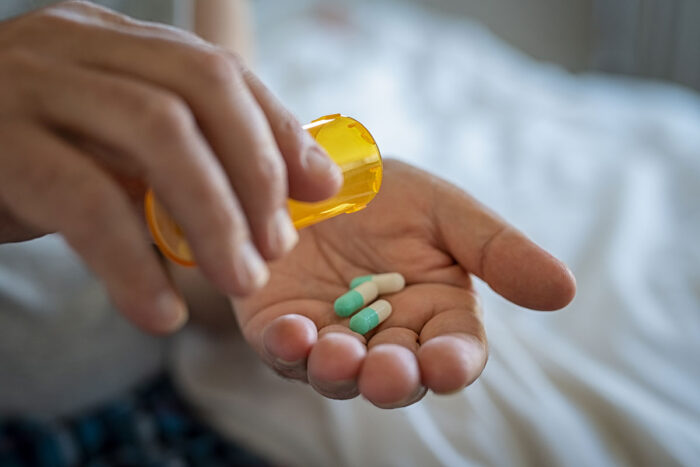Finding alternatives to traditional antibiotics aim of $11 million grant
Team aims to treat bacterial infections without antibiotics, develop new class of antibiotics
 Getty Images
Getty ImagesResearchers at Washington University School of Medicine in St. Louis have received an $11 million grant from the National Institute of Allergy and Infectious Diseases to combat drug resistance by finding ways to treat bacterial infections without antibiotics, and studying a potential new class of antibiotics.
Researchers at Washington University School of Medicine in St. Louis have received an $11 million grant from the National Institute of Allergy and Infectious Diseases of the National Institutes of Health (NIH) to find new ways to combat the growing threat of antibiotic resistance.
The grant funds a two-pronged approach. One aims to identify and develop alternatives to antibiotics for urinary tract infections (UTIs) and other infections caused by drug-resistant bacteria. The other is exploring the potential for antibiotic development of GmPcides, a novel class of molecules that kills a wide variety of bacteria in the lab when used alone, and boosts the bacteria-killing properties of other antibiotics when used in combination with them.
“Antibiotic resistance is reaching a tipping point,” said principal investigator Scott J. Hultgren, PhD, the Helen L. Stoever Professor of Molecular Microbiology. “It’s getting harder and harder to treat bacterial infections because so many of them are resistant to all of the antibiotics we have.”
Nearly 3 million people develop drug-resistant bacterial infections in the U.S. every year, leading to more than 35,000 preventable deaths, according to a 2019 report from the Centers for Disease Control and Prevention (CDC). Overuse of antibiotics helps drive the spread of antibiotic resistance. More than 270 million antibiotic prescriptions are written in the U.S. every year, many of them — more than 10% — for treatment of UTIs. Replacing antibiotics with alternative therapies for UTIs could significantly reduce overall antibiotic usage.
Hultgren and colleagues including James W. Janetka, PhD, a professor of biochemistry & molecular biophysics, have shown that mice with UTIs caused by Escherichia coli (E. coli) — the most common cause of UTIs — can be treated with sugar-based decoy molecules that block bacteria from attaching to the bladder wall. Without a handhold, the bacteria are flushed away during urination. The beauty of this approach is that it cures the infection without killing the bacteria, thereby avoiding putting pressure on bacteria to acquire antibiotic resistance genes to survive. These molecules, called mannosides, are in human clinical trials.
As part of this grant, Hultgren leads a team that will search for similar alternatives to antibiotics for other drug-resistant bacteria that cause UTIs, including catheter-associated UTIs, the most common infection acquired by hospitalized patients. The researchers will screen panels of sugar-based molecules and antibodies for their ability to block bacterial attachment. Janetka is using structure-based drug design to construct compounds that bind to and inhibit those bacterial proteins that bind to sugars. Ali Ellebedy, PhD, an associate professor of pathology & immunology, of medicine and of molecular microbiology, will produce the antibodies for screening.
Meanwhile, Peng Yuan, PhD, an associate professor of cell biology & physiology, is taking a different approach to disarming disease-causing bacteria without killing them. Bacteria produce long filaments called pili that they need to cause disease but not to survive. In principle, eliminating a bacterium’s pili could convert a dangerous bacterium into a harmless one.
The molecular machinery to build pili is remarkably similar across all so-called Gram-negative bacteria, one of the major divisions of the bacterial world. Yuan leads an effort to screen panels of rationally designed small molecules — designed and synthesized by Fredrik Almqvist, PhD, a professor of organic chemistry at Umea University in Sweden — and antibodies — produced by Ellebedy — for molecules that can sabotage the pili-building molecular machinery of drug-resistant Gram-negative bacteria that have been categorized as urgent or serious threats by the CDC. The group includes Acinetobacter and members of the Enterobacteriaceae family, which cause health care-associated infections; Campylobacter, Salmonella and Shigella, which cause diarrhea; Pseudomonas aeruginosa, which causes pneumonia; and Bordetella pertussis, which causes whooping cough.
Another group, led by Michael G. Caparon, PhD, a professor of molecular microbiology, is studying a novel class of molecules called GmPcides that were developed in collaboration with Almqvist and Hultgren. GmPcides target Gram-positive bacteria, the other major division of bacteria, including all drug-resistant Gram-positive species identified by the CDC as urgent or serious threats.
“GmPcides can disarm antibiotic resistance,” said Hultgren. “Many antibiotics are not useful because the bacteria have become resistant to the antibiotic. However, if you add both a GmPcide and the antibiotic together, this overcomes the resistance and the bacteria are killed. This effect happens even when the concentration of GmPcide is too low to kill the bacterium on its own. We’ve shown this in mice — it’s not been done in humans yet — but it’s very exciting because it means we may have found a way to salvage some antibiotics that have been shelved due to widespread resistance.”
Caparon’s studies will investigate how GmPcides work. Using this knowledge, they will develop more potent versions that can be potentially translated for use in people.







